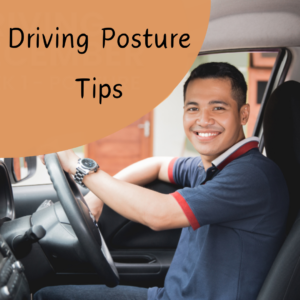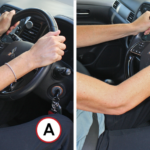This article has been kindly shared by Alison Richmond from Provention.
Long drives, whether for holidays or for work can be both exciting and tiring. Unfortunately, they often leave us with unwelcome aches and pains in the back, neck, and shoulders.
If this sounds familiar, keep reading! We’ve got tips and advice to help you stay physically comfortable while driving – plus check out our other posts on Your Grip on the Steering Wheel – Why It’s Essential to Stretch & Take Breaks on Long Drives – Prolonged Driving Injuries
Below Alison is sharing tips on driving posture and proper seat setup – a critical step to ensure a pain-free ride.
Good Posture Explained
Although a car environment differs from an office or home workstation, the principles of good posture remain universal. Sitting properly in your car can make a significant difference in how your body feels during and after your drive.
If you’ve been dealing with back, neck, or shoulder pain while driving, revisiting these basics can work wonders.
Quick Tips for a Comfortable Driving Set Up
Here are some practical adjustments you can make to optimise your sitting position and reduce tension during your drive:
1. Avoid an Upright Backrest at 90 Degrees
Many people think having their backrest perfectly upright is ideal, but holding this position for extended periods usually forces you into a slumped posture over time. This “poking chin” posture, with your upper back raised away from the backrest and your neck craned forward, creates tension and discomfort in the neck and shoulders.
Suggestion:
Recline your backrest slightly—about 5-10 degrees—to ensure a more relaxed and sustainable posture. This subtle change helps prevent slumping.
2. Don’t Push Your Backside Too Far Back
Pushing your backside all the way to the back of the seat can lead to the same slumping issue. Over time, your spine will strain to hold this position.
Suggestion:
“Shuffle” your backside forward a little to relax your lower back. This adjustment will help your lumbar spine relax and allow your upper back to rest naturally against the seat. There’s no need to “slide down” dramatically; just enough for your spine to feel supported and relaxed against your backrest.
3. Adjust the Steering Wheel and Seat Position
Most modern cars have adjustable steering wheels, allowing you to bring the wheel closer or move it further away. Use this feature to achieve a balance that’s comfortable for both your arms and legs.
That said, sometimes compromises are necessary.
Tips:
- Changing your posture periodically during long drives distributes the strain on your muscles and prevents stiffness from building up over time.
- Listen to your body and keep moving!
- The key to avoiding discomfort is being mindful of your body.







